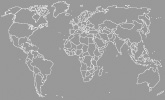Biography
Exhibitions
Articles
- C. F. Schroer, Landkarten (German)
- Speech of Jaap Bremer, NL (2005, German)
- KUNSTFORUM 214 (German)
- Stones and Stardust
- Steine und Sternenstaub (German)
- Engelbert Broich, (English)
- Engelbert Broich, (German)
- Stadtanzeiger Köln (German)
- Tucson Weekly, 07/27/2000
- Plateau Magazin, 1999
- Herald Tribune, 07/17/1999 (Prof. Dr. D. Galloway)
- The Hindu, 02/15/2002
- Heaven On Earth
- Interview
News
Earth paintings
Meteroite paintings
Rockart
Projects
Impressions
Press
Books
Music
Earth Tones
Ulrike Arnold's Art Literally Rises From The Soil
by Margaret Regan (from Tucson Weekly july 27th)
The narrow mountain canyon where Bisbee nestles is a glorious swathe of coppery rock and brown soil. Steep slopes of orange and red tower above the picturesque old mining town, and their rich mineral colors naturally make their way into any portrait of the place.
Yet German artist Ulrike Arnold, in her painting "Bisbee, Arizona, 1998", does more than just hint at these geological hues. They are the painting. Gone are the town's blue desert sky and eccentric 19th-century wooden houses. In Arnold's vision the colors of the rocks -- and the rocks themselves -- stand in for the place. The actual pigments of Bisbee's minerals become the "paint" for her painting. And Arnold doesn't stop at color. The actual texture of this grainy land shows up on the canvas, an almost 3-D potpourri of tiny pebbles and grains of soil.
"I do not want to crate a reproduction of a landscape," Arnold has written, "but rather a microcosmic intensification of it."
Her twist on the landscape genre gives a whole new meaning to the term regional art. One of the newish breed of environmental artists, she travels around the world in search of new places to "paint," relishing each new location's distinct textures, colors, soils and stones. Other environmental artists sculpt the earth into new shapes, as Arizonan James Turrell is doing to a crater on the edge of the Painted Desert, or they set crafted burial mounds on fire and record the moment in photography, as did the late Ana Mendieta. Arnold, instead, combines what she's gathered from the earth with artists' materials.
Typically, the artist begins by collecting the stones and soils of a place, and grinds down the rock into fine powders that become her paint pigment. She stabilizes the coppery soils and shiny mica by mixing them with oils, wax and resin, and then she slathers the delicious goo onto rough canvases with her bare hands. The resulting abstractions are a sensuous swirl. Their earth tones and large gestures suggest prehistoric cave paintings, while their sophisticated compositions align them with contemporary abstraction.
An itinerant artist who's made her environmental portraits on five continents, Arnold first visited Flagstaff 10 years ago, and returned here in the late 1990s to make a new series of regional works. This summer she's exhibiting a series of Arizona and New Mexico pieces at the UA's Joseph Gross Gallery. The show, appropriately called Earth Paintings, features 10 mixed media wall works and an elegant floor piece that shows off Mother Nature's astonishing palette.
No fewer than 162 white cloth sacks are arranged in a grid on the floor, each one filled with a different kind of rock or soil that has at one time or another made its way into an Arnold artwork. One bag contains only chunks of green rock, another a gray, asphalty soil, still another golden dust. Then there's reddish-brown dirt, white rocks, glittery mica, and on and on.
While the bags would tempt any visitor to plunge their hands right on in (don't try it, it's not allowed), their allure makes us a little jealous of the pure pleasure Arnold must get from making her arty mud pies. How long has it been since the rest of us played in the dirt? The sacks are a reminder too that artists' colors generally come from mineral sources--that is, the earth itself. Arnold just creatively simplifies the usual transfer process from earth to canvas.
A couple of her New Mexico paintings were done at Abiquiu in homage to its most famous resident, painter Georgia O'Keeffe. These works prove once and for all that New Mexico is pinker than Arizona. "Abiquiu, New Mexico," 1998, a horizontal rectangle about 39 inches long by 26 inches high, is a curvaceous rendering in pink-gray soil and ochre and reddish brown, the celebrated colors of O'Keeffe's own paintings. It's a lovely, pastel evocation of a lovely place. "Guadalupe Canyon, New Mexico," 1998, likewise is a delicate pastiche of pale pink, green, gold and brown.
Over to the west, in fiery Arizona, Arnold finds much more in the copper range, a suitable thing in a state of mining heritage. In fact, "Flagstaff, Arizona," 2000, is ablaze with gold and ochre, a conflagration of color that sizzles with danger. Volcanoes once raged near Flagstaff, and Arnold delights in the black ash left behind by the long-ago lava. In her bold "Flagstaff, Arizona," 1993, a delectable cascade of rich black dirt curves rhythmically around white and black and gold.
But her Bisbee painting is the copper queen. A big triptych some 12 feet long and 5 feet high, "Bisbee, Arizona" is a geology lover's prize. The colors are all there, to be sure--gold, orange, rust, red-brown--but Arnold evokes the old mining days by the way she's layered them on. Like untapped veins of ore, her colors and textures snake across the raggedy canvas, a true "microcosmic intensification" of Bisbee's land and history.
Ulrike Arnold: Earth Paintings continues through Thursday, August 10, at the Joseph Gross Gallery at the University of Arizona, located just south of the pedestrian underpass at Park and Speedway. Gallery hours are 10 a.m. to 5 p.m. Monday through Friday. For more information call 621-6142.

